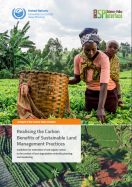
"Land degradation is one of the threats to human and natural systems. Fortunately, over the past few decades awareness of this challenge has grown, and 122 countries have committed to setting land degradation neutrality (LDN) targets, of which 84 have officially validated their targets, and 51 have put their targets into legislation. In this concept, LDN is achieved if new degradation is balanced by reversal of degradation elsewhere in the same land type by restoration or rehabilitation. The primary instrument for achieving LDN is through the implementation of sustainable land management (SLM) practices.
Because of its multifunctional roles and its sensitivity to land management soil organic carbon (SOC) was selected as one of three indicators for LDN. Compared with the other global LDN indicators, that is, land cover change and land productivity dynamics (LPD) (measured as net primary productivity), SOC is challenging to manage and monitor at large scales. Moreover, SOC density in soils can vary greatly, even on the scale of meters, and fluctuates over time, for example between seasons. Comparative evaluation of SOC change between different SLM options (e.g. for land planning), tracking SOC dynamics through time (i.e. SOC monitoring) and effectively mapping SOC changes at large scales (e.g. for verifying LDN achievement) requires the combination of rigorous soil sampling schemes and the use of software tools/biophysical models for SOC assessment.
To provide practical guidance to support the deployment of SLM interventions to maintain or enhance SOC stocks, for LDN and for other objectives such as landbased climate change adaption and/or mitigation a series of decision trees was developed, based on the latest available knowledge. This report reviews and compares available tools and models for SOC estimation.
It presents practical guidance for land managers and puts forward policy-oriented proposals. Guidance for land managers emphasizes the selection of SLM practices to maintain or enhance soil organic carbon and achieve LDN. It addresses the choice of SLM practices suited to the local socio-economic and biophysical context; methods for measurement and monitoring of SOC; and the use of tools/models for SOC assessment to estimate SOC and map SOC, and how to choose an appropriate tool/model according to the purpose.
Policy-oriented options include to (i) share the guidance for land managers at the appropriate level; (ii) monitor SOC change as an indicator of SLM intervention to support assessment of LDN achievement in 2030; (iii) apply gender-responsive actions addressing gender-based differences and promote gender equality and women’s empowerment; (iv) design a framework for LDN Planning and means to support it."

